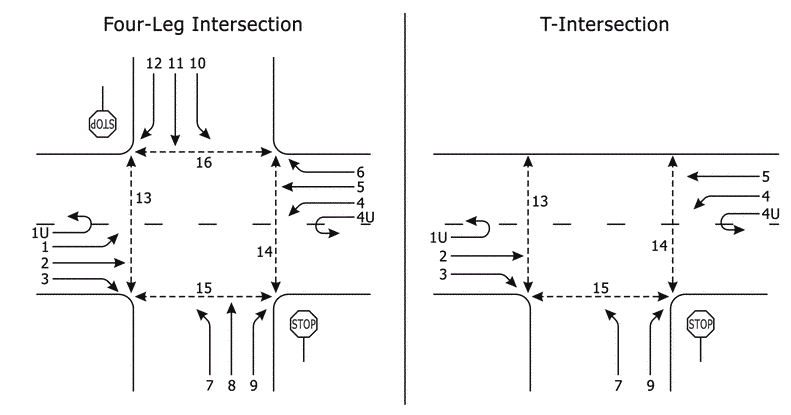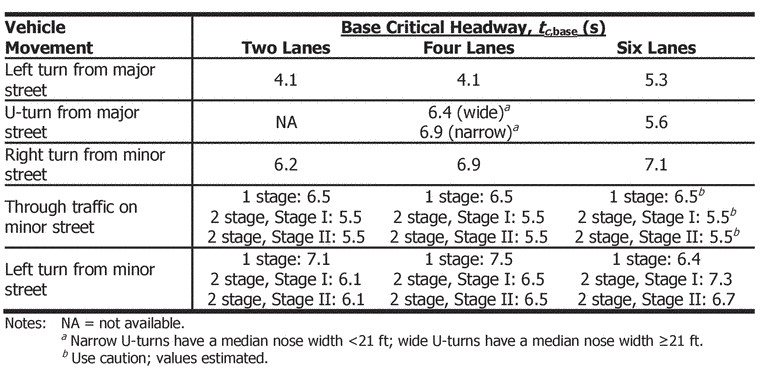11 Unsignalized Intersections
11.1 Overview
Vehicles that are subject to control (yield or stop sign) at unsignalized intersections operate according to the rules of the road and gap acceptance theory.
11.2 Gap Acceptance
Gap acceptance models begin with the recognition that two-way-stop-controlled (TWSC) intersections give no positive indication or control to the driver on the minor street as to when it is appropriate to leave the stop line and enter the major street. The driver must determine when a gap on the major street is large enough to permit entry, based on the relative priority of the competing movements.
This decision-making process has been formalized analytically into what is commonly known as gap acceptance theory. Gap acceptance theory is the basis for the TWSC and roundabout intersections operations analysis of the Highway Capacity Manual (Transportation Research Board and National Academies of Sciences, Engineering, and Medicine (2022)).
This theory includes three elements:
Availability of Gaps
Usefulness of Gaps
Relative Proportions of Various Movements at the Intersection
The availability of gaps is the proportion of gaps of a particular size on the major street offered to the driver entering from a minor movement, as well as the pattern of vehicle arrival times. The distribution of gaps between vehicles in the different streams has a major effect on the performance of the intersection.
The second element pertains to how useful drivers find the size of the gap when attempting to enter into the intersection. It is generally assumed within gap acceptance that drivers are both consistent and homogeneous. However, studies have demonstrated that different drivers have different gap acceptance thresholds and even that the gap acceptance threshold of an individual driver often changes over time.
The third element in gap acceptance theory concerns the ranking of each movement in a priority hierarchy. Typically, gap acceptance processes assume drivers on the major street are unaffected by the minor movements. If this assumption is not the case at a given intersection, the gap acceptance process has to be modified.
For TWSC methodology, priority hierarchy must be identified for each movement. Movements can be categorized by right-of-way priority as follows:
- Movements of Rank 1 include through traffic on the major street, right-turning traffic from the major street, and pedestrian movements crossing the minor street.
- Movements of Rank 2 include left-turning and U-turning traffic from the major street, right-turning traffic onto the major street, and pedestrian movements crossing the major street.
- Movements of Rank 3 (subordinate to Ranks 1 and 2) include through traffic on the minor street (in the case of a four-leg intersection) and left-turning traffic from the minor street (in the case of a T-intersection).
- Movements of Rank 4 (subordinate to all others) include left-turning traffic from the minor street. Rank 4 movements occur only at four-leg intersections.

Figure 11.1: TWSC Priority, Vehicular (solid arrows) and Pedestrian (dashed arrows) Movements (Transportation Research Board and National Academies of Sciences, Engineering, and Medicine (2022))
Headway times are used as a measurement instead of gaps due to the ease of calculation and requiring less information.
Critical Headway and Follow-up Headway
Critical headway, \({t_c}\), is defined as the minimum time interval in the major-street traffic stream that allows intersection entry for one minor-street vehicle. Thus, the driver’s critical headway is the minimum headway that would be acceptable. A particular driver would reject headways less than the critical headway and would accept headways greater than or equal to the critical headway. Critical headway can be estimated from observations of the largest rejected and smallest accepted headway for a given intersection.
The time between the departure of one vehicle from the minor street and the departure of the next vehicle using the same major-street headway, under a condition of continuous queuing on the minor street, is called the follow-up headway, \({t_f}\). Thus, \({t_f}\) is the headway that defines the saturation flow rate for the approach if there were no conflicting vehicles on movements of higher rank.
Computing Critical Headway and Follow-up Headway
Critical Headway \({t_{c,x}} = {t_{c,base}} + {t_{c,HV}}{P_{HV}} + {t_{c,G}}G-{t_{3LT}}\)
where:
\({t_{c,x}} =\) critical headway for movement x (s),
\({t_{c,base}} =\) base critical headway from “Base Critical Headways” (s) below,
\({t_{c,HV}} =\) adjustment factor for heavy vehicles (1.0 for major streets with one lane in each direction; 2.0 for major streets with two or three lanes in each direction) (s),
\({P_{HV}} =\) proportion of heavy vehicles for movement (expressed as a decimal; e.g., \({P_{HV}} = 0.02\) for 2% heavy vehicles),
\({t_{c,G}} =\) adjustment factor for grade for given movement (0.1 for Movements 9 and 12; 0.2 for Movements 7, 8, 10, and 11) (s),
\(G =\) percentage grade (expressed as an integer; e.g., \(G = −2\) for a 2% downhill grade), and
\({t_{3LT}} =\) adjustment factor for intersection geometry (0.7 for minor-street left-turn movement at three-leg intersections; 0.0 otherwise) (s).

Figure 11.2: Base Critical Headways for TWSC (Transportation Research Board and National Academies of Sciences, Engineering, and Medicine (2022))
Follow-up Headway \({t_{f,x}} = {t_{f,base}} + {t_{f,HV}}{P_{HV}}\)
where:
\({t_{f,x}} =\) follow-up headway for movement x (s),
\({t_{f,base}} =\) base follow-up headway from “Follow-Up Headway” (s),
\({t_{f,HV}} =\) adjustment factor for heavy vehicles (0.9 for major streets with one lane in each direction; 1.0 for major streets with two or three lanes in each direction), and
\({P_{HV}} =\) proportion of heavy vehicles for movement (expressed as a decimal; e.g., \({P_{HV}} = 0.02\) for 2% heavy vehicles).

Figure 11.3: Base Follow Up Headways for TWSC (Transportation Research Board and National Academies of Sciences, Engineering, and Medicine (2022))
Roundabouts
The operation of roundabouts is similar to that of two-way STOP-controlled intersections. At roundabouts, however, entering drivers scan only one stream of traffic, the circulating stream, for an acceptable gap.